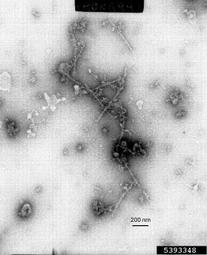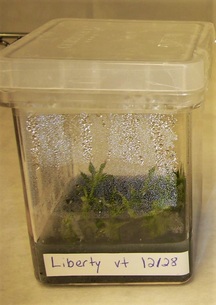 David Gent, USDA Agricultural Research Service, Bugwood.org Carnation Latent Virus (Carlavirus CLV) David Gent, USDA Agricultural Research Service, Bugwood.org Carnation Latent Virus (Carlavirus CLV) New hopyards should carefully select the source of their initial planting stock. Why? Disease causing pathogens naturally accumulate in plants and the maximum crop yield potential falls as time passes over a period years. Many people rationalize this as the plants are “getting old”. Virus and viroids accumulation is an important consideration in long-lived crops like hops. The normal productive years of a commercial hopyard variety that starts with few or no viruses present is about 10 to 12 years before they are typically replaced with new fresh plants. Initial planting stock that is obtained from old hopyards as rhizomes often contain high levels of viruses/viroids. The USDA is aware of this and has a congressional mandate to provide clean seed and planting stock for all commercially important crops. Hops are included in this list and reputable professional propagators source and use this clean nuclear mother stock whenever possible from the USDA source. Great Lakes Hops (GLH) actively searches for, obtains, maintains, and propagates the cleanest nuclear mother stock available (emphasis on AVAILABLE) to us in our specialized MDOA licensed nursery facility. Most of our nuclear mother stock is sourced directly from the USDA National Clean Plant Program / Facility located in the western USA. This is the only current recognized source of hop propagation stock that has been treated and tested for virus removal and is certified With a VF number at the time of its release. We do not propagate or sell hops or rhizomes as a sideline or as non-inspected planting stock. All of our hop transplants are grown specifically for new hop acreage. However, that being said - read carefully and understand the following. 1. Not all hop cultivars are treated and maintained for virus removal due to lack of commercial use and the lengthy time and expense involved to remove viruses. Newer popular hop cultivars have higher priority to be treated for virus removal in the USDA program. Older hop cultivars considered no longer commercially important are typically only virus indexed. This distinction means potential propagation stock with known virus loads are only tested for different viruses and identified - not necessarily removed or treated. This plant material is referred to as virus indexed stock. Indexed hop stock is be replaced by virus-treated stock if cleaner versions becomes available to GLH. 2. Even the most popular individual hop cultivars are only retreated for virus removal every 5 to 8 years. If it is determined that the hop cultivar is still commercially important and the viruses have re-accumulated to a level that warrants re-treatment. (See the USDA National Clean Plant Program for their detailed program specifications and methods.) GLH's role as a propagator of hop stock is to maintain and multiply larger numbers of these USDA obtain hop cultivars to commercial hopyards using the cleanest propagation methods available. It takes GLH two full seasons to propagate and ramp up to commercially available quantities of the newly acquired USDA mother stock. It is a very specialized process, and is little appreciated unless you are a fellow propagator who has created thousands of replicate plants from a single mother plant. 3. Any "virus free" claims made by any other hop propagation/nursery suppliers are misleading in our opinion and the term is only directly applicable to the original mother stock plant obtained directly from the USDA program. This is due to how quickly easily hop re-acquire viruses. Even the USDA program does not warranty or certify the individual nuclear mother hop plants provided remain virus free once they leave their lab facilities. It is now known that viruses may survive the virus removal treatment and may still be present a low levels that are not detectable by current virus testing methods. These latent viruses rebuild to detectable levels over a period of several months. GLH produces cloned hop transplants that originated from these limited USDA mother plants and the resulting transplants may be tagged to show this origination. This tag identification is in no way, shape, or form indicative that these cloned transplants are certified or re-tested individually to be "virus-free". 4. All life forms accumulate viruses/ viroids and other pathogens – that is the reality of nature. Viruses/viroids accumulate naturally in plants over time; therefore the effort to monitor and replace heavily virus infected plants in commercial hop cultivation is a continually ongoing effort. Yes- even "clean" plants naturally re-acquire viruses and that is why they have to be continually refreshed as years pass. Note that plants also contain beneficial virus/ viroids that may be removed by the non-selective removal treatment process. Most virus tests are also nonspecific and only indicate possible virus/ viroid groups or classes. 5. Hopyard plant populations rarely show uniform virus expression. In large commercial hop yards; virus expression is quite sporadic and often will often not be visible unless plants are stressed by other factors. Large commercial hopyards routinely rouge out individual weak plants that express heavy virus symptoms and replace them with rhizomes from other plants in the same field. This is a normal grower practice and is similar to how virus levels are managed in many other perennial crops. 6. Worries over viruses in hopyards have been overblown, in our opinion. Over the past decade, GLH has repeatedly tested rhizomes sourced from numerous huge PNW hopyards. We have yet to find one sample that tested negative for viruses from these sources. These hopyards are aware of the numerous viruses and viroids present and yet are very successful at growing and providing the majority of the hops used worldwide.  GLH germplasm cleanup and breeding program GLH germplasm cleanup and breeding program New inexperienced growers often over-react when their hopyards test positive for viruses. The immediate conclusion is that having viruses means they are doomed to failure and all the plants need to be immediately destroyed. This is a false flag because the vast majority of all established commercial hopyards in the world contain the same viruses and viroids. New hop growers should realize that hundreds of other hopyards are growing the same plant material cloned from the same original female plant and are very successful growers. An example: the German cultivar 'Nugget' was known to carry a very heavy virus load of multiple types of virus without effect except when placed under extreme field stress; yet reported yields from growers were as high as 2400# dry/acre. "Cascade" hops were also evaluated in university trials with the presence of viruses having little to no effect on yields. It is far more common to find during a full professional consult of growers' under-performing hopyards that it is actually case of improper cultural practices. Lack of water and fertilizer at critical times, incorrect soil pH, soil compaction, and poor disease and weed controls are evident as the main contributing factors to poor hop vigor and yields. Often there is no adequate control of insects and weeds that are known vectors. Hop growers should re-examine every aspect of their cultural programs before accepting the presence of virus as the sole explanation to their problems. GLH continually monitors hop vigor levels in all our produced hop transplants in our own trial yards. We replace propagation stock with cleaner plants in a regular rotation. The USDA is aware that the increased interest in growing more hop varieties for craft brewers has put more pressure on them to ramp up the budgets and programs that produce more treated mother hops that hop propagators use to create hopyard transplants. GLH is a MDARD licensed and inspected plant nursery. Further reading: Detection and Elimination of Viruses in USDA Hop (Humulus lupulus) Germplasm Collection Viruses and Viroids Infecting Hop: Significance, Epidemiology, and Management |
Details
Blog AuthorLynn, the head hop grower at Great Lakes Hops has over 30 years of experience in the horticultural field. Browse the blog articles here to find useful growing information for humulus lupulus, based on personal experience and observations at Great Lakes Hops. Archives
January 2020
Categories
All
|


 RSS Feed
RSS Feed